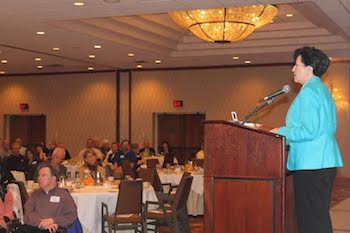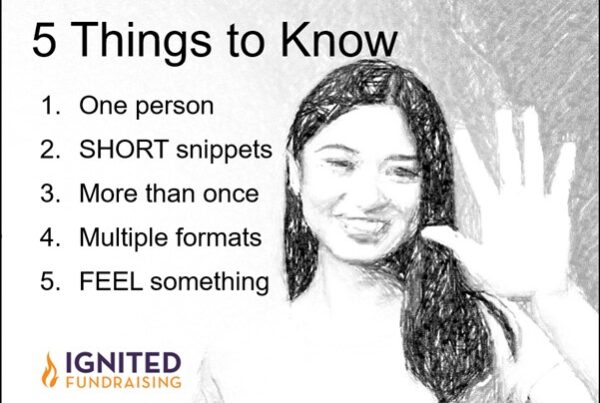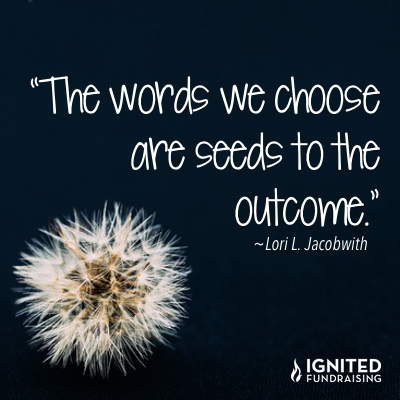Tis the season for fundraising events! And for giving speeches about why people should give to your organization.
If you are “THE ONE” chosen to give that inspiring speech. . . please keep it short. Less than seven minutes is best. (That’s about 1000 words, depending on your cadence of delivery.)

Before anything else, be authentic!
After coaching hundreds of fundraising event speakers — speeches that have gone from raising a few thousand dollars to raise millions. . . I’ve seen too many people with a boring uninspiring delivery.
You can have a fabulous outline but if you are not authentic and you read from a script with your head down. . . you’ll have wasted an opportunity to generate support.
NOTE: These best practices can be used for longer presentations as well.
Lori’s Seven Best Practices for Event Speakers
1. Gain audience attention & interest
• HEAR them.
• Ask a question they have to think about.
• Get a raise of hands.
• Be sure your remarks, speech, or presentation feels like it is about THEM in some way.
2. Establish your own credibility & approachability
• This is critical when speaking.
• This is where you can insert a short story to connect more deeply.
• Include some of your most relevant and/or impactful “stats.”
3. Share three main concepts
• Put your remarks or your presentation into “buckets” with interesting, engaging titles.
• Of course you can and will want to include sub-topics in those “buckets” to cover all
you want to, but remember: less is more.
• Too many topics can be confusing and your audience loses interest.
4. Make it easy to follow along
• Make sure you keep your talk/presentation orderly by reminding the audience
where you are in the overall outline.
• Do this visually with a common graphic or numbers or verbally with a transition
phrase or numbers. e.g. Let’s dive into my third point: “Why your investment
makes such an impact.”
5. Transitions are key
The best presentations flow with transitions that are virtually invisible.
6. General guidelines for inserting stories/Impact examples
• Three stories in a short, seven-minute speech.
• You may absolutely use more people examples or “stories” in a longer presentation but
make them relevant and short.
• Use them to:
• Emphasize your point
• As a transition
• To insert drama, clarity, humor
• To close your remarks/presentation
7. My biggest pet peeve: Do not use the phrase: “In closing…”
• We all know that you’ll stop talking eventually so do that. But do it in a
“conversational” format.
• They are listening and you are talking, but in an exceptional speech or presentation
you’ve had them following you closely and they are ready for the finale.
• One trick I use: I often ask, “What will you do differently after today?”
Sometimes I have the opportunity to hear their answers out loud, sometimes not. The question shifts listeners to the wrap up while getting them into action about what they just heard.
A Terrific Resources for Speakers:
Number of words to number of minutes calculator







Trying to put an opening speech for a fund raising event for a nonprofit organization. Helping students in Africa.
I need help on how to put it together.
Organization needs school supplies, stationary, computers nd other necessary supplies for school purposes.
I want a speech that will convince the audience to help the organization financially to achieve their course.
Hello Kolleh,
What I believe you may want it to deliver what is called the “visionary leader” message. Where has your organization been, where is it today and where are you heading. I recommend no longer than 7 minutes to inspire others with your message. And do weave in at least 2 or three stories of how your organization in making a difference for one or two students. Here is a link to a description of a shorter type message, but it may help you get started: https://ignitedfundraising.com/give-exceptional-curtain-message/
Here is a link to the reminder to always make your stories about one person at a time to cause people to care deeply: https://ignitedfundraising.com/nonprofit-storytelling-one-vs-many/
And finally, this message pyramid may be helpful as you craft your speech: https://ignitedfundraising.com/i-dont-want-to-ask-people-for-money/
Good luck!
Please link me a good speech that will get into the audience head.Anniversary and fundraising event
Hello Nick,
While I don’t have the ability to provide a link to an exact speech the answers provided to Kolleh on this post, on August 6 are an excellent outline for a speech. Here is a link that should help: https://ignitedfundraising.com/give-exceptional-curtain-message/
Good luck to you!
I am the guest speaker for a children’s hospital fundraiser. The purpose is to share my emotional, moving story about my son and our experience at the hospital, highlighting our specific child life programs we benefitted from, that their donations support. I journaled while in the ICU with my son. These journal writings are becoming the foundation for my book. They are heartfelt and tell the story. The speech needs to be 6-9minutes. I was thinking I’d thank everyone… then read from my journal entries. They were actually Facebook posts (I had asked for prayers and therefore felt that I owed it to everyone to keep them posted) and the response to my writing was overwhelming. What do you think of this format? It would almost be like an author reading. Everyone responded how I helped them and how inspiring I was and what a good writer I was… so I figured, why re-invent the wheel?
I am the guest speaker for a children’s hospital fundraiser. The purpose is to share my emotional, moving story about my son and our experience at the hospital, highlighting our specific child life programs we benefitted from, that their donations support. I journaled while in the ICU with my son. These journal writings are becoming the foundation for my book. They are heartfelt and tell the story. The speech needs to be 6-9minutes. I was thinking I’d thank everyone… then read from my journal entries. They were actually Facebook posts (I had asked for prayers and therefore felt that I owed it to everyone to keep them posted) and the response to my writing was overwhelming. What do you think of this format? It would almost be like an author reading. Everyone responded how I helped them and how inspiring I was and what a good writer I was… so I figured, why re-invent the wheel?
Heidi, I’m honored you took time to read my post and share a bit of your story. YES is my answer. I often coach speakers for fundraising events and the most challenging part is to get them to share authentic thoughts and feelings. Your journal/Facebook posts, read as a recap of your journey no doubt are authentic, heart-felt, and inspiring. My advice: Keep them wanting more. So, read a few – pausing briefly between each of the posts – allow the emotion to build…and then thank the audience for helping your family and so many others they may never meet. Hold some details back…but take them on your journey. And best of luck to you! Warmly, Lori